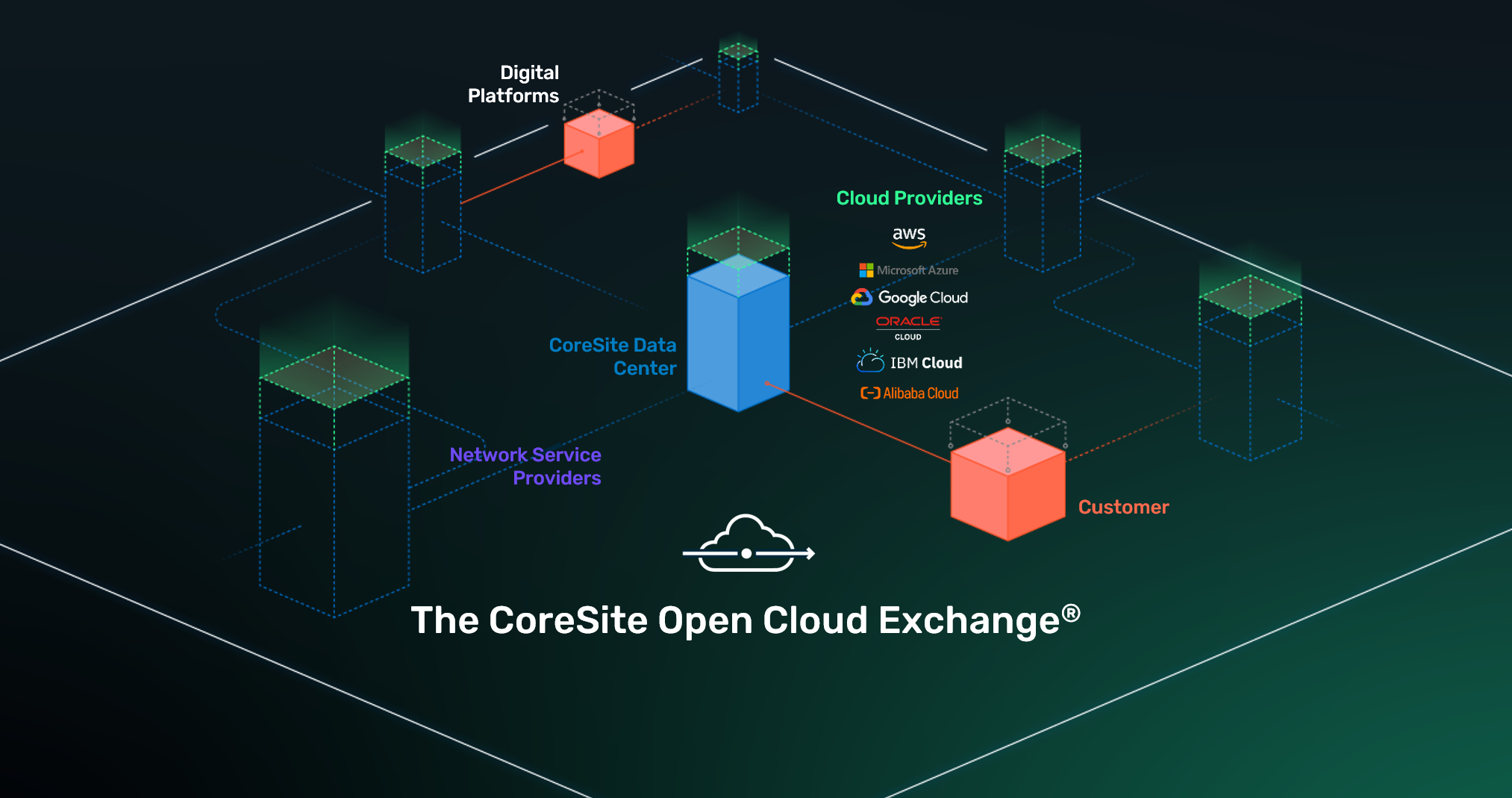
Simplifying Multi Cloud Networking for Hyperscale Clouds
Arrcus and CoreSite have teamed up to simplify multicloud network connectivity by enhancing the provisioning functionality within the Open Cloud Exchange® (OCX) platform. In this blog, Shekar Ayyar, CEO and Chairman of Arrcus, discusses the Arrcus Connected Edge Multi Cloud Networking software (ACE MCN), how it works to support OCX and the value the combination offers CoreSite data center customers.
Arrcus was founded to enhance business efficiency through superior network connectivity. The Arrcus Connected Edge (ACE) platform offers best-in-class networking with the most flexible consumption model at the lowest total cost of ownership. Arrcus ACE supports leading enterprise, cloud and communications providers with software-defined routing and switching.
How did you come to know CoreSite and build a relationship?
We were looking for a colocation provider to support us for data center network capacity, and we started talking to CoreSite. We developed a relationship and it has evolved to what it is today, a partnership in which Arrcus’ ACE MCN, a multicloud virtual routing solution, is an integral part of the OCX platform.
How does the Arrcus Connected Edge work with and leverage the OCX?
The OCX is an enterprise network services platform that allows customers to more easily deploy hybrid IT architectures. They can plug in and provision services seamlessly, almost to a point where it can be self-service capacity provisioning. The OCX backend connects to multiple pools of capacity, not all of which come from CoreSite data centers – they also could be clouds such as Microsoft Azure and AWS. This connection requires the right kind of routing and transport technology. Think of the Arrcus Connected Edge as the routing fabric that supports the OCX by enabling cloud-to-cloud connectivity.
Historically, three types of capacity pools have been distinct and unconnected. The first is resident in enterprise private data centers. The second is in siloed clouds. The third is inside telecom carriers’ network environments, either mobile or fixed line. The goal is to enable customers to blend these pools of capacity and provision across them – and to create applications that can be programmed on top of a uniform API/SDK-like interface. The OCX looks at these capacity pools almost as one virtual element and can use its orchestration capability to launch or spawn virtual routers in different clouds.
When you combine the Arrcus Connected Edge and the OCX, you have a powerful platform that allows CoreSite to provide capacity and network functions. For example, a customer might want a certain type of cybersecurity. It can be deployed when the OCX works in concert with Arrcus’ virtual routing. You can communicate a policy to our virtual routers, and it’s implemented in our software. The point is that the OCX can become the one interface that starts provisioning capacities across clouds, enterprise pools and telecom/communications/mobile network environments.
Here’s another example. Let’s say you’re an enterprise or service provider network engineer and you want to avoid complex manipulations related to managing each individual network as you try to consume capacity across the broad, giant, connected web. This is where we come in. We allow you to focus more on network functions and services that you create and deploy rather than on the underlying complexity of connecting things.
The democratization of networking is mentioned in the Arrcus mission statement. Why is this concept important?
Where we begin the democratization journey is decoupling the hardware and software. Of course, many people are innovating in hardware, whether at the processor or original design manufacturer levels. On the software side, we at Arrcus want to tie threads together so customers don’t have to use 15 or whatever number of different operating systems. Instead, they can view this as one common fabric versus having different libraries of commands unique to each cloud or telco.
Democratization is opening up a way in which more people can build applications and create service solutions through a platform like the OCX. Industry standardization increasingly makes things more available to more people. What customers should do is look at how vendors are enabling open architectures and choice, and no longer insisting on siloed environments. Through the use of industry standard protocols and APIs, the underlying infrastructure is becoming more programmable. To me, this tremendously increases the potential for new monetizable services, and Arrcus is helping to move the ball forward with our ACE software platform and solutions like MCN.
What is your vision of a holistic digital infrastructure?
In the area of applications benefiting from communications and cloud convergence, I think we are right now where the internet was in its infancy, similar to early DARPA projects talking about email and connecting a few things. No one envisioned the giant web, let alone the applications that were delivered on top of the web. Things like work from home and the pandemic have more recently accelerated the journey, but people yet ask the question about killer apps for 5G or the edge. I’m a big believer that if you create a cross-domain programmable infrastructure, you will have a flood of new applications that are well beyond what anyone imagines. And there will be commercial app marketplaces similar to Apple’s App Store, or an Android equivalent.
I believe the direction we are headed is toward a place where you or I or anyone who is an application developer can focus on building new classes of connected applications. Of course, we still need to address privacy concerns and data and who gets access to what, and this is likely to take a few cycles to iron out. At the end of the journey, you can wake up one morning, create an application and connect hundreds of thousands or maybe billions of people around the world. At Arrcus, 5G (soon 6G), edge computing and multi-cloud networking are the three infrastructure catalysts we threw into the pot to boil. Then out came the ACE platform that enabled us to support next generation, connected edge applications.
What is the most important message you want to convey?
Customers like and will pay for true value – they hate to be forcibly held. In this case, we’re talking about simplification and push-button capability to enable robust multi-cloud networks that connect across different domains. And people want this to happen fast, easily, and economically.
The CoreSite Perspective: Enterprise Benefits

Earlier in this post, Shekar hit the nail on the head when he said, “When you combine the Arrcus Connected Edge and the OCX, you have a powerful platform that allows CoreSite to provide capacity and network functions.”
As part of developing this post, we asked John Jensen, Manager, Network Reliability at CoreSite, to provide insight on advantages that the integration of OCX with the Arrcus Connected Edge, which we will refer to as OCX ENS, (OCX Enhanced Network Services) can create. Here are several advantages you should keep in mind as you continue to interconnect your digital ecosystem.
First, OCX ENS lowers the “barrier of entry” to private Layer 3 connectivity into cloud resources.
As you probably know, Layer 3 is the network layer within the seven-layer scheme known as the Open Systems Interconnection model (OSI model). IP routing within and between networks occurs at Layer 3, and that includes routing between a customer’s on-prem network and one or more networks in their cloud environment. Every cloud provider requires the use of a dynamic routing protocol called Border Gateway Protocol (BGP) for routing traffic between customer’s networks “in the cloud” and customer’s networks outside of it.
Most smaller organizations don’t have a technical need for in-house staff or consultants with the requisite expertise for designing or engineering network interconnection that requires the use of BGP. Unfortunately, this creates a skill gap, if one of these organizations has any interest in connecting to the cloud. Our new service offering aims to bridge this gap by simplifying the required BGP configuration to interconnect these organizations to the cloud, whether over the internet or via on-prem deployment in the datacenter or branch office.
Furthermore, OCX ENS can help free up resources to concentrate on projects that inspire innovation and help you reach business objectives. It also facilitates rapid prototyping of network architectures for hybrid cloud deployment, enabling network architects to iterate on multicloud applications in development without purchasing equipment. Once projects move to implementation, the company can decide whether to go ahead and take the plunge on the capital expense or keep the implementation virtual, whatever is best for the long-term. The bonus is that not only is the CapEx burden reduced, speed to market for the application is accelerated.
CoreSite would like to thank Shekar Ayyar for taking the time to share his thoughts. You can learn more about the Arrcus/CoreSite relationship by reading this press release.
And, to learn more, check out the Open Cloud Exchange and Arrcus Connected Edge. If democratization of technology interests you, read the blog, “The Democratization of Connectivity.”

Shekar Ayyar
Chairman and CEO, Arrcus
Shekar Ayyar is a seasoned technology executive and industry leader with more than 25 years of experience spanning general management, research, strategy, mergers and acquisitions and business development.








